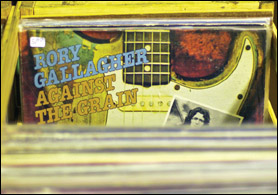 In the late ’50s vinyl came into my world, and I remember it like it was yesterday, looking at the step-up racks of records featuring the great artists of the time: Elvis Presley, Jerry Lee Lewis, Eddie Cochran, Chuck Berry, Gene Vincent, Carl Perkins, etc. Their album covers made an indelible, lasting impression.
In the late ’50s vinyl came into my world, and I remember it like it was yesterday, looking at the step-up racks of records featuring the great artists of the time: Elvis Presley, Jerry Lee Lewis, Eddie Cochran, Chuck Berry, Gene Vincent, Carl Perkins, etc. Their album covers made an indelible, lasting impression.
By the late ’60s I was buying all kinds of records: Muddy Waters, Paul Butterfield, Savoy Brown, Ten Years After, Fleetwood Mac, John Mayall, Howlin’ Wolf, Taste, The J Geils Band and Buddy Guy, to name a few. This led me to open the Zig Zag Record Store in Brooklyn in the ’70s, and four others later on. This period was truly the “Golden Age” of vinyl. The store’s original concept was built around my love of vinyl: only records, no cassettes or 8-track tapes. We sold all types of vinyl: new and used LPs, 45s and 78s; out-of-print, collectible records and (especially) imports from all over the world (we sponsored the legendary radio show “Things from England” on WNEWFM, hosted by the late Scott Muni). One of the first record shops to build our business around the record collector, we didn’t sell Top 40 music unless the artist fit in with what we sold, artists like the Rolling Stones, the Beatles, the Who, Led Zeppelin, Bob Dylan, etc. During this “Golden Age,” record collecting started to become a major hobby as collectors began to specialize in many different genres: Beatles, Elvis Presley, rockabilly, imports, new wave, heavy metal, punk, garage bands, blues, jazz, country, picture sleeve 45s, promo copies, audiophile and mono pressings.
Throughout the ’70s, the vinyl market grew yearly, but that changed in the mid-’80s with the introduction of the CD. The music industry called it the “perfect format” and wanted everybody to get rid of their vinyl (not me!) and re-buy their collections on CD. I saw the writing on the wall and sold my last record store in 1986.
By the early ’90s it looked as though vinyl was dead; U.S. record companies were not pressing records, and people were trading in their LP collections for next to nothing (a move many have lived to regret). During this time I took a trip to Japan and saw vinyl still alive and well, and this made me refocus my thoughts. (How ironic that Japan started the digital revolution to begin with!) Like many others, I realized records were a much better way to listen to music: the packaging was much better, the sound was better, and the experience of holding an album in your hands blew CDs away. Face it, a record is a real piece of art.
By the end of the ’90s, vinyl started to come back with the help of record collectors’ shows held all over the world. Record shows in New York (WFMU), Austin, Cleveland and Philadelphia have become events not to be missed, and international shows like the one in Utrecht (Holland) are a vinyl junkie’s dream. Some great record stores like Younger than Yesterday, Princeton Record Exchange, Last Vestige, Amoeba, Academy and Waterloo have survived and thrived. Fine magazines such as Goldmine and Record Collector (UK) continue to serve collectors well. Internet sites such as eBay have proven to be a major factor in keeping collectors aware of what is available all over the world.
Labels have started to produce new vinyl again, with indies like Sundazed, Akarma, Classic and 4 Men with Beards leading the way. Many high-end record labels cater to the audiophile, and even the majors have gotten back into the act, with artists like Bob Dylan and Neil Young always sure to have some vinyl pressed on their releases, if only on a limited basis. It’s frustrating that many releases do not come out in the vinyl format—that is the number one complaint that I hear from customers at Bluestormmusic.com.
As I see it, vinyl will keep growing, and though it will never reach the heights it did in the early and mid ’80s, it will remain the preferred “collectors” format as long as the true music fan keeps supporting it. Spread the word to upcoming generations and help keep vinyl alive so it can do its part in American music.
—Arnie Goodman



Be the first to comment!